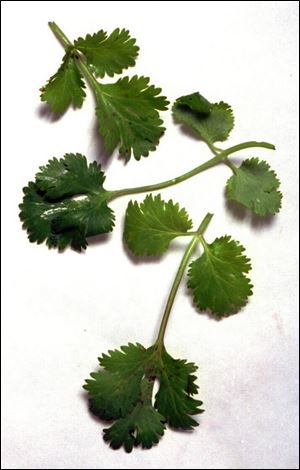
Cilantrophobes, your time has come
8/12/2014
Cilantro.
Pity the conscientious restaurant chef trying to accommodate the ever more demanding dietary needs of her customers. This one is gluten-free, that one can’t eat dairy. Another is allergic to tree nuts, and still another won’t eat cilantro.
Wait. What?
Cilantro? The savory herb that gives so much of Mexican and Tex-Mex food its distinctive flavor?
I’d never heard of such a thing. So I called Nur Reinhart, a self-described cilantro hater who says that for people like her, eating foods containing the herb is like gnawing on a bar of soap. And it’s often hard to avoid.
“I recently had a long chat with a waiter about an appetizer and he assured me there was no cilantro in it,” she said. “Guess what? The dish arrived polluted with a liberal sprinkling — I suppose for decoration.”
Reinhart isn’t a picky eater. She loves Mexican food. The reason she can’t stand cilantro may be in her genes.
Several years ago, Charles J. Wysocki of the Monell Chemical Senses Center in Philadelphia asked identical and fraternal twins attending the annual Twins Day Festival in Twinsburg, Ohio, whether they liked cilantro. Wysocki reasoned that if preference was genetically based, there should be a stronger correlation in the identical twins, since they share 100 percent of their genetic makeup, than in the fraternal twins, who share only 50 percent. ("Fraternal twins are siblings who just happen to be born at the same time,” Wysocki said.)
And, indeed, that’s exactly what he found.
Further research has identified two regions of the genome that may be responsible for this preference.
But what’s most interesting about Wysocki’s work is that he found it’s not the taste of cilantro that puts people off, it’s the smell.
Taste and smell are closely intertwined so to prove this, he plugged the noses of cilantro haters and gave them leaves to eat. One said it was like chewing on grass. But when the nose plugs were removed he exclaimed, “There’s that evil smell!”
There are many components that make up the aroma of cilantro, including the soaplike smell that cilantrophobes often complain about. For these people, the soapiness tends to overpower the plant’s more pleasant, savory aroma. Those who enjoy cilantro are better able to detect the pleasant components than the unpleasant ones.
Whatever the reason, chefs, especially those working in San Antonio’s many Tex-Mex restaurants, are finding they have one more thing to contend with when it comes to preparing meals. Cilantro is also a popular ingredient in the cuisines of other Latin American countries, as well as in Asian cooking.
“We get plenty of questions about whether dishes contain cilantro or whether it can be left out of them,” said Zachary Garza, chef de cuisine of The Frutería, in San Antonio. “I do what I can to accommodate them.”
Sometimes that’s easy, sometimes it’s not.
If, for example, someone asks for cilantro-free guacamole, he can quickly and easily mash up some fresh avocado. It’s not the same product, but it’s something he said he’s proud to serve.
It’s when they ask for cilantro-free guacamole with all the trimmings — tomato, onion, peppers, etc. — that it becomes an issue.
“To do that I’d have to take 10 minutes to make one bowl for one customer,” he said. “And that’s going to back up the line and affect other customers.”
He also laughs about those who wait until they’ve been served their meal to announce that they’re “allergic” to cilantro.
“The only thing you can be allergic to in cilantro is the chlorophyll, which would mean you can’t eat any green vegetables,” said Garza, a graduate of The Culinary Institute of America — Hyde Park in New York. “Someone who is allergic to a food will be very specific about what it is they can’t eat and why. And they don’t wait. They’ll let you know almost as soon as they walk in the door.”